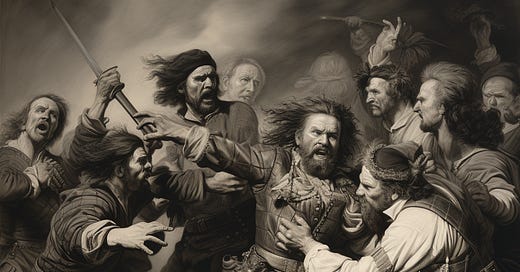Dunoon Castle, nestled on the scenic shores of Cowal in Argyllshire, is a silent witness to centuries of Scottish history. Believed to have been constructed between the tenth and twelfth centuries, it stood as the formidable stronghold of the Lamonts, the chieftains of the Cowal district. The castle's strategic location, perched on a promontory overlooking the Firth of Clyde, made it a coveted prize in the power struggles of medieval Scotland.
Read the new article from our daily premium feed : The Exploits of Colkitto
The Feud Begins
The roots of the Dunoon Massacre can be traced back to the appointment of Campbell of Lachawe as the hereditary keeper of Dunoon Castle. This move, initially intended as a reward for his loyal support of the Crown, sowed the seeds of bitterness between the Lamonts, the castle's original owners, and the Campbells. This animosity marked the commencement of a relentless feud between Clan Campbell and Clan Lamont, a feud that would persist for over three centuries, defining the lives of countless individuals on both sides.
The Marquis of Argyll's Resolve
By 1646, the Marquis of Argyll, a prominent figure in Clan Campbell, had grown determined to bring an end to this protracted conflict. His resolve to exterminate Clan Lamont was unyielding. He meticulously planned simultaneous attacks on the two remaining Lamont strongholds: Toward Castle and Ascog Castle, both situated on the picturesque Isle of Bute.
The Betrayal and Capitulation
The attacks on Toward Castle and Ascog Castle were executed with military precision, culminating in the capitulation of both fortresses. The terms of surrender, ostensibly designed to bring an end to the violence, appeared straightforward. According to these terms, the Lamonts were to be allowed to go free, a gesture of clemency meant to mark the end of hostilities. However, treachery lurked in the hearts of the victors. As soon as the doors of the castles swung open to the besiegers, the Campbells perpetrated a shocking betrayal. They made prisoners of the Lamonts and their loyal supporters.
The Massacre
What followed can only be described as a nightmarish descent into madness. The Campbells, driven by an unfathomable rage, perpetrated a bloodbath of unspeakable brutality. Lamont men, women, and even infants were ruthlessly slain. The savagery extended to wounded individuals, some of whom met a horrifying fate, reportedly buried alive beneath the blood-soaked earth. The Provost of Rothesay, though gravely wounded, faced an exceptionally gruesome end. His attackers, devoid of any humanity, went to grotesque lengths to ensure his demise.
The Legend of the Tree
The aftermath of the massacre gave birth to a chilling legend that would persist through the ages. The tree on which the Lamonts were hanged, a macabre gallows, took on a supernatural aura. In the years that followed, it was said that from the heart of this accursed tree, a spring of a substance resembling blood bubbled forth. Many regarded this eerie spectacle as a miraculous occurrence, while others believed it held curative properties. It became a haunting, tangible reminder of the horrors that had unfolded.
Uprooting the Memory
As time passed and the wounds of the Dunoon Massacre began to fester, the memory of the bloodshed became an unbearable stain on the Campbell legacy. The Campbells eventually decided to erase this ghastly reminder from the landscape. The stump of the infamous tree was uprooted, and beneath it, they discovered a substance that resembled congealed blood. This act, symbolic in its nature, marked the end of the Dunoon Massacre and the history of Dunoon Castle itself.
The Lasting Impact
The Dunoon Massacre, though overshadowed by other historical atrocities, left an indelible mark on the region. The protracted feud between Clan Campbell and Clan Lamont had exacted a heavy toll on both sides for centuries. The massacre's brutality and treachery shook not only Scotland but also reverberated throughout the world. It serves as a stark reminder of the destructive power of feuds and the importance of seeking reconciliation, even in the face of centuries-old vendettas.
Remembering Dunoon
Today, the Dunoon Massacre stands as a solemn testament to the cost of intergenerational conflict. It serves as a haunting reminder of the need for empathy and understanding in our world today. The legend of the tree and the spring, though eerie, continue to captivate the imagination of those who visit the area. They serve as poignant reminders of the tragedy that unfolded centuries ago, urging us to reflect on the consequences of our actions and the enduring quest for peace in a world too often marked by strife.






Sorry but I have to inform you that both Toward and Ascog Castle are on the Cowal peninsula and not the isle of Bute. Toward Castle is in the village of Toward past Dunoon. Ascog Castle is at Loch Ascog between Millhouse and Portavadie.